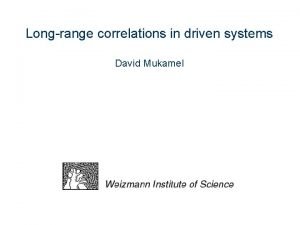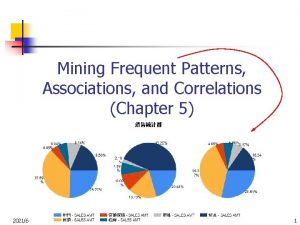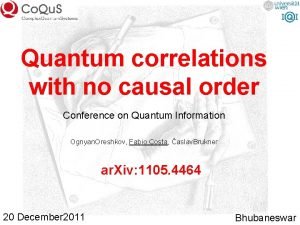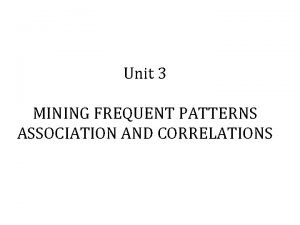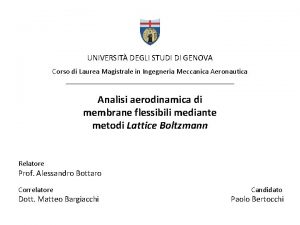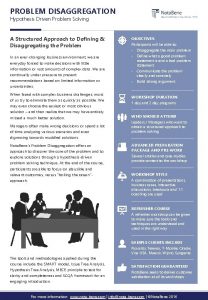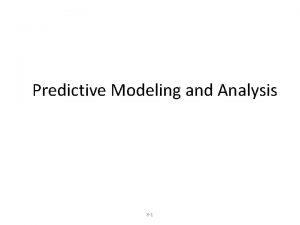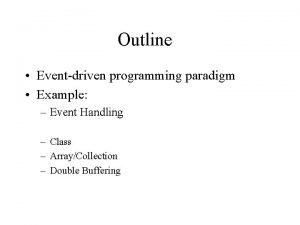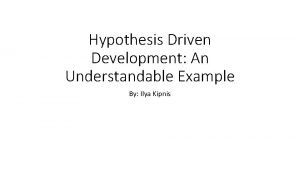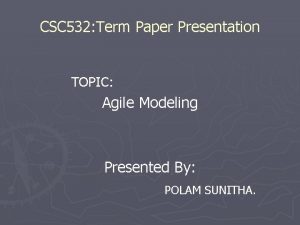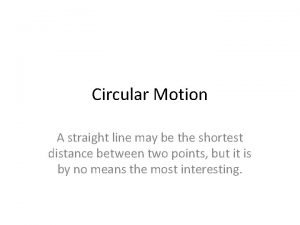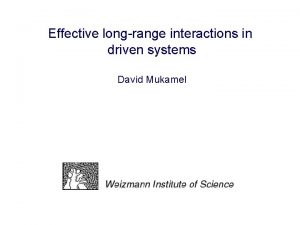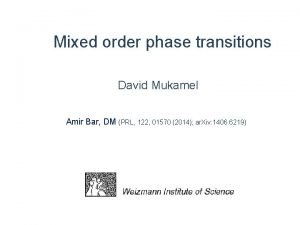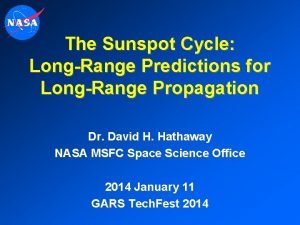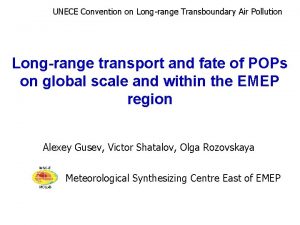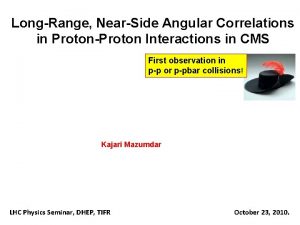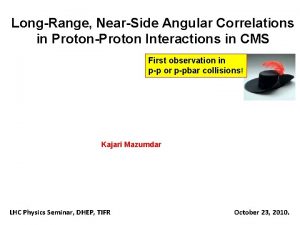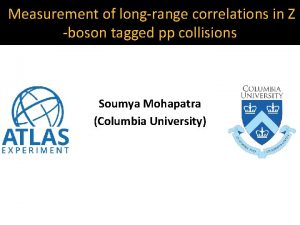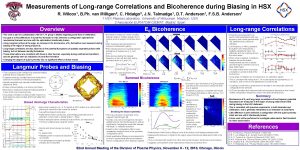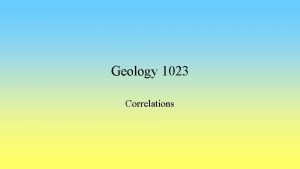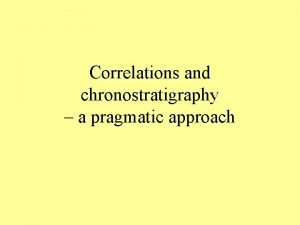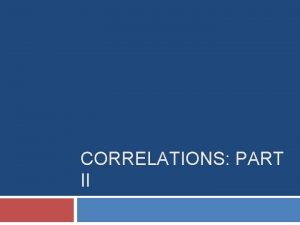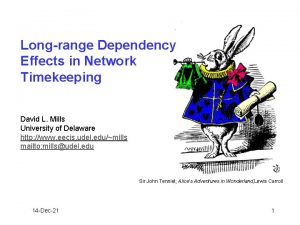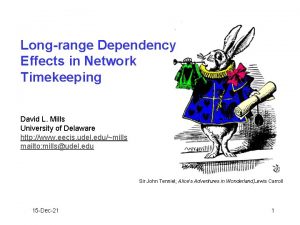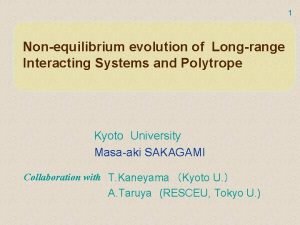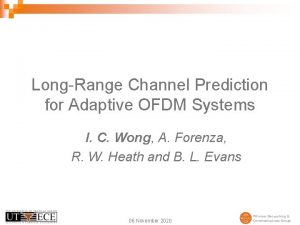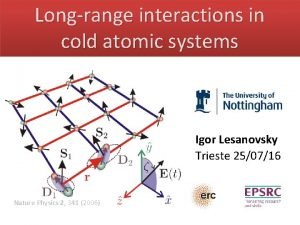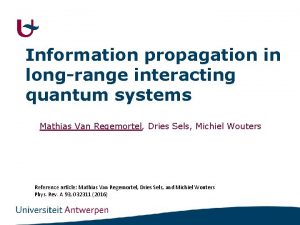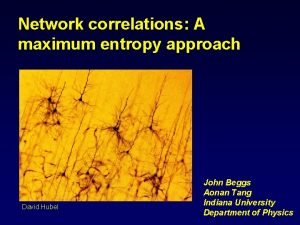Longrange correlations in driven systems David Mukamel Driven




























































- Slides: 60

Long-range correlations in driven systems David Mukamel

Driven, non-equilibrium systems with currents do not obey detailed balance

Typical simple examples heat current T 1 T 2 T 1>T 2 charge current E What are the steady state properties of such systems? It is well known that such systems exhibit long-range correlations when the dynamics involves some conserved parameter.

Outline Will discuss a few examples where long-range correlations show up and consider some consequences Example I: Effect of a local drive on the steady state of a system Example II: Linear drive in two dimensions: spontaneous symmetry breaking

Example I : Local drive perturbation T. Sadhu, S. Majumdar, DM, Phys. Rev. E 84, 051136 (2011)

Local perturbation in equilibrium Particles diffusing (with exclusion) on a grid N particles V sites Prob. of finding a particle at site k

Add a local potential u at site 0 1 1 N particles V sites 0 1 1 The density changes only locally. 1

How does a local drive affect the steady-state of a system?

A single driving bond

Main results: In d ≥ 2 dimensions both the density and the local current decay algebraically with the distance from the driven bond. The same is true for local arrangements of driven bond. The power law of the decay depends on the specific configuration. In d=2 dimensions a close correspondence to electrostatics is found, with analogous variables to electric and magnetic fields E, H.

Density profile (with exclusion) along the y axis in any other direction

Non-interacting particles • The steady state equation

The dipole strength has to be determined self consistently. Green’s function solution Unlike electrostatic configuration here the strength of the dipole should be determined self consistently.

Green’s function of the discrete Laplace equation pq 0 0 0 1 2


density: current:

Multiple driven bonds

Two oppositely directed driven bonds – quadrupole field


The model of local drive with exclusion Here the steady state measure is not known however one can determine the behavior of the density.

The density profile is that of the dipole potential with a dipole strength which can only be computed numerically.

Simulation results

Magnetic field analog

Zero-charge configuration The density is flat however there are currents

Zero magnetic field configuration no currents but inhomogeneous density (equilibrium)


Example II: a two dimensional model with a driven line T. Sadhu, Z. Shapira, DM

Two dimensional lattice gas (Ising) model (equilibrium) + particle - vacancy particle exchange (Kawasaki) dynamics


2 d Ising model with a row of weak bonds (equilibrium) +


Interface energy at low temperature: 1 d Quantum mechanical particle (discrete space) with a local attractive potential. The wave function is localized.

Schematic magnetization profile

Consider now a line of driven bonds + -


Main results The driven line attracts the interface The interface width is finite (localized) A spontaneous symmetry breaking takes place by which the magnetization of the driven line is non-zero and the magnetization profile is not antisymmetric, (mesoscopic transition). The fluctuation of the interface are not symmetric around the driven line. These results can be demonstrated analytically in certain limit.

Results of numerical studies The is attracted by the driven line. Time= 3 e 9 Time= 5 e 9 Time= 6 e 9

A configuration of the periodic 500 X 501 lattice at temperature 0. 85 Tc.

Temporal evolution of the interface position Periodic 30 X 31 lattice at temperature 0. 6 Tc. Driven lane at y=0, there around 15 macro-switches on a 10^9 MC steps.


Zoom in Macroscopic switch Mesoscopic switches Periodic 30 X 31 lattice at temperature 0. 57 Tc.

Example of configurations in the two mesoscopic states for a 100 X 101 with fixed boundary at T=0. 85 Tc

Schematic magnetization profiles unlike the equilibrium antisymmetric profile

Asymmetric magnetization profile for a periodic 500 X 501 lattice at temperature T=0. 85 Tc.


Non-symmetric fluctuations of the interface A snapshot of the magnetization profile near the two interfaces on a 500 X 501 square lattice with periodic boundary condition at T=0. 85 Tc.

Closed boundary conditions In order to study the mesoscopic switches in more detail and to establish the existence of spontaneous symmetry breaking of the driven line we consider the case of closed boundary conditions - - - - + + + +

Time series of Magnetization of driven lane for a 100 X 101 lattice at T= 0. 6 Tc.

Switching time on a square LX(L+1) lattice with Fixed boundary at T=0. 6 Tc.

Averaged magnetization profile in the two states L=100 T=0. 85 Tc

Analytical approach In general one cannot calculate the steady state measure of this system. However in a certain limit, the steady state distribution (the large deviation function) of the magnetization of the driven line can be calculated. Slow exchange rate between the driven line and the rest of the system Low temperature

Schematic potential (large deviation function)

Slow exchange between the line and the rest of the system In between exchange processes the systems is composed of 3 sub-systems evolving independently

Low temperature limit In this limit the steady state of the bulk sub systems can be expanded in T and the exchange rate with the driven line can be computed.






Summary Driven systems exhibit long range correlations under generic conditions. Such correlations sometimes lead to long-range order and spontaneous symmetry breaking which are absent under equilibrium conditions. Simple examples of these phenomena have been presented. A limit of slow exchange rate is discussed which enables the evaluation of some large deviation functions far from equilibrium.
 David mukamel
David mukamel Associations and correlations in data mining
Associations and correlations in data mining Analisis korelasi bivariat
Analisis korelasi bivariat Closed patterns and max-patterns
Closed patterns and max-patterns Quantum correlations with no causal order
Quantum correlations with no causal order Spurious correlations
Spurious correlations Thinking critically
Thinking critically Mining frequent patterns associations and correlations
Mining frequent patterns associations and correlations Business driven information systems
Business driven information systems Decision support systems and intelligent systems
Decision support systems and intelligent systems Dicapine
Dicapine Embedded systems vs cyber physical systems
Embedded systems vs cyber physical systems Engineering elegant systems: theory of systems engineering
Engineering elegant systems: theory of systems engineering Using risk to balance agile and plan driven methods
Using risk to balance agile and plan driven methods Interrupt driven io
Interrupt driven io Equazione di boltzmann
Equazione di boltzmann Jelaskan teknik arbitrasi bus
Jelaskan teknik arbitrasi bus Text-driven approach
Text-driven approach Fixed power driven woodworking tools
Fixed power driven woodworking tools Tools and equipment
Tools and equipment Staged event-driven architecture
Staged event-driven architecture Sap hana value proposition
Sap hana value proposition Attribute-driven design
Attribute-driven design Hypothesis driven problem solving
Hypothesis driven problem solving Positioning kotler
Positioning kotler Logic driven predictive models
Logic driven predictive models Event driven programming paradigm
Event driven programming paradigm Hawthorne motivation theory
Hawthorne motivation theory Model driven dss
Model driven dss Model driven architecture
Model driven architecture Api driven ddi
Api driven ddi Market driven strategy adalah
Market driven strategy adalah Data driven instruction quotes
Data driven instruction quotes Mano simulator
Mano simulator Intelligent agent peas examples
Intelligent agent peas examples Next generation soc
Next generation soc Understandable example
Understandable example Is a gesr a wheel
Is a gesr a wheel Participant-driven research
Participant-driven research Event driven process chain examples
Event driven process chain examples Event management in itil
Event management in itil Identity driven security
Identity driven security Raceways and fittings
Raceways and fittings Des fleet operations
Des fleet operations Data warehouse terminology
Data warehouse terminology Metadata driven ingestion framework
Metadata driven ingestion framework Data driven districts
Data driven districts Individual marketing
Individual marketing Designing a customer driven marketing strategy
Designing a customer driven marketing strategy Creating value for target customers
Creating value for target customers Agile model driven development amdd
Agile model driven development amdd Effort driven in ms project
Effort driven in ms project Event driven programming in java
Event driven programming in java A 250 kg motorcycle is driven around a 12 meter tall
A 250 kg motorcycle is driven around a 12 meter tall Time driven model of leadership
Time driven model of leadership Introduction to retail business
Introduction to retail business Market sensing, customer linking and channel bonding are
Market sensing, customer linking and channel bonding are Amca 500-l
Amca 500-l Market-driven significato
Market-driven significato Knowledge driven dss example
Knowledge driven dss example Data driven web applications
Data driven web applications
